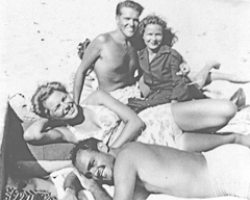
Editor’s note: This was written by Jim Arnold on April 21, 1985.
Memories are a little like corks left out of bottles. They swell. They no longer fit. However, the memories of the early days in Seal Beach are so very special. It is a joy to try and recapture their flavor.
Good does come from evil. Had it not been for contracting polio as an infant, the chances of ever sharing in the uniqueness that is Seal Beach would never have happened in my life experiences. In the mid-1920s, an Australian nurse recommended moist sand and water for recuperation of post-polio patients. An older sister of mine, (Romaine) had discovered the joys of Seal Beach Tent City and suggested to my father that we try it. In 1925, we rented the upstairs of what was then The Gibson House in the 1500 block of Seal Way. The next two seasons we enjoyed The Scott House in the same block. Then came the opportunity to purchase four lots with a small cabin on two of them in the 1600 block—and we have been here ever since.
My memories are limited. Not in concept, but in space. I seldom ventured further away from the surf and sand than Ocean Boulevard. Our lives were run by the tide table, the Pacific Electric Red Cars, and the whistle from the Electric Plant on First Street. The big adventure was to tag along when Old Carl brought the daily mail, with the occasional visit to The Green Parrot. The sand and sea were my world. The only boundaries were my ability to see the dishtowel whenever it might appear on the porch post signaling me to hurry home. Digging for clams at low tide in the sandbar that stretched out under what is now the east end of the Navy Jetty, and discovering the wonders of the tide pools that exposed themselves along the deep channel that fed Anaheim Landing and the marshes behind it that is now Huntington Harbour.
No TV, no radio (at our house anyway)—but time was spent with wonderful people. Mostly Tent City Folk. We organized small singing groups and put on plays for our own amazement along the boardwalk. It really was a board walk then, often lying so high above the changing sand levels that a ladder was needed to get down to the water! Leonard Henkey, Walter Wolf, Patsy Miller, Helen Binley, Vivian Peterson, Margaret and Mary White are people fondly remembered from those days in the late 1920s.
The Rollercoaster was still in evidence, the Dance Halls of the twin buildings sometimes held Marathon Dances, and the Green Hotel at Central and Main would be passed with awe and speculation concerning the daring do’s supposed to be going on inside! Special evenings we would gather at the Henkey’s to listen to CHANDU The Magician on their radio—then cover our heads with netting to escape the hordes of mosquitoes that made life after dark a bit of a challenge. Citronella was the cologne of everyone.
Most of the daytime was spent at Anaheim Landing. I wasn’t walking well, but before the days of the Jetty, it was possible to enter the water in front of our place and drift through the channel to Burns’ (on the Silver Strand) or to Anaheim Landing itself, with the Bowling Alley and the very best hamburgers in the world! We Ky-yakked and canoed (ask anyone of that era about the charms of Hog Island!). We dove from the Auto Bridge, and risked life and limb avoiding the Pacific Electric Red Cars to get to our favorite fishing spot over the channel—or our special ledge from which to contemplate the finer things of life. Then when the tide turned, we would drift back through the channel through the cross-waves of the sand bar, and to our front door.
The “main man” in this segment of time was Earl Whittington, Lifeguard Extraordinaire. He did his civic and lifeguard duties well, and added that certain something that comes from being a very special person. He opened all kinds of doors that had been closed to me through either denial or inclination—convincing me there was nothing one couldn’t do if they tried hard enough. His teaching, his sense of humor, and his marvelous patience with the obstreperous young people around him endeared him to everyone. Our group even paraphrased a popular tune of the day, rehearsed and performed it for him at a special “service” at The Landing. He reacted as if it was almost as meaningful to him as it obviously was to us.
Marcella O’Sullivan, (we can thank her for today’s Greenbelt) her brother Joe, Millie Eagleston, Marie Spencer, Jody Gillis, the Kumer twins Betty and Dorothy, Bobbie Martin, Winnie Howard, Hoarace Scheiflie, and Ray Pitts were all a part of this wonderful world of swim and song and cards and congeniality.
After the earthquake in 1933, our cabin was augmented to include a “bunkhouse” that furnished shelter for my Pasadena-bound summer friends. The bunks were seldom empty. Through High School, and my days at Pomona College it was seemingly “Open House.” The only rules laid down by my wonderful parents—No Booze and No Girls! Those rules worked well for years.
In 1941, it was necessary to start several years of experimental surgeries (which didn’t work out as hoped) and that allowed me to experience the in between times on the Boardwalk in a wheelchair, in the springtime as well as in winter. It was wonderful! This was mainly because of the super people that would pause to pass the time of day. Importantly in this group were some fine local young folk who decided I should see more than the block in front of our house. They took turns walking me to the Pier, along Main Street, and the Landing. Their enthusiasms caused one complication.
A particularly beautiful spring day had them stop by en route to the school bus. One thing led to another, and they missed the bus. Truant!
The better part of the day was spent ducking behind the dunes whenever anyone passed by. The frustration came to the explosive stage when other young people began appearing on the beach before the expected time. It was learned that the principal had died suddenly that morning and school had been dismissed! In spite of this, they have remained special friends through the years.
The war years came, the Naval Weapons Station was built and times were highlighted by the furloughs of the men in service who felt the same charm of Seal Beach that they felt for their hometowns. It seemed as if we were running a local USO, and it was wonderful.
As a matter of fact, Seal Beach has given me a happy childhood, a happy youth, and a happy middle age. With the help of the Coastal Commission and the local planning board, I count on a happy old age, and then I’m going straight to Heaven!
Epilogue
Jim and his lovely wife did rebuild their home in 1986. They spent their retirement years enjoying their family, visitors and volleyball games at their home on Seal Way. Jim was able to go directly from home to heaven on April 26, 2006.
His wife still walks the boardwalk each day with her dog.



